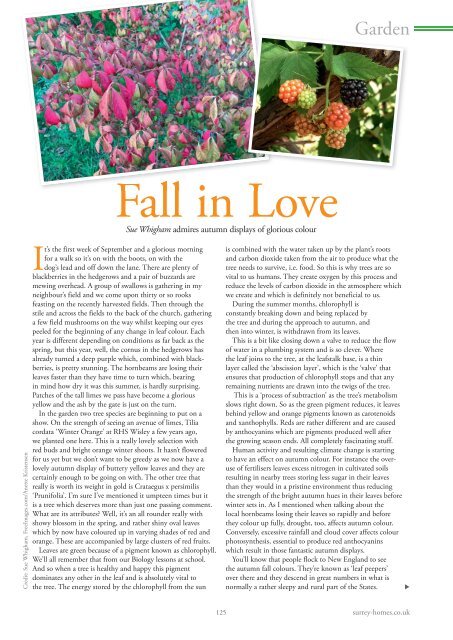Surrey Homes | SH36 | October 2017 | Kitchen & Bathroom supplement inside
The lifestyle magazine for Surrey - Inspirational Interiors, Fabulous Fashion, Delicious Dishes
The lifestyle magazine for Surrey - Inspirational Interiors, Fabulous Fashion, Delicious Dishes
Create successful ePaper yourself
Turn your PDF publications into a flip-book with our unique Google optimized e-Paper software.
Garden<br />
Fall in Love<br />
Sue Whigham admires autumn displays of glorious colour<br />
Credit: Sue Whigham, FreeImages.com/Anette Kristensen<br />
It’s the first week of September and a glorious morning<br />
for a walk so it’s on with the boots, on with the<br />
dog’s lead and off down the lane. There are plenty of<br />
blackberries in the hedgerows and a pair of buzzards are<br />
mewing overhead. A group of swallows is gathering in my<br />
neighbour’s field and we come upon thirty or so rooks<br />
feasting on the recently harvested fields. Then through the<br />
stile and across the fields to the back of the church, gathering<br />
a few field mushrooms on the way whilst keeping our eyes<br />
peeled for the beginning of any change in leaf colour. Each<br />
year is different depending on conditions as far back as the<br />
spring, but this year, well, the cornus in the hedgerows has<br />
already turned a deep purple which, combined with blackberries,<br />
is pretty stunning. The hornbeams are losing their<br />
leaves faster than they have time to turn which, bearing<br />
in mind how dry it was this summer, is hardly surprising.<br />
Patches of the tall limes we pass have become a glorious<br />
yellow and the ash by the gate is just on the turn.<br />
In the garden two tree species are beginning to put on a<br />
show. On the strength of seeing an avenue of limes, Tilia<br />
cordata ‘Winter Orange’ at RHS Wisley a few years ago,<br />
we planted one here. This is a really lovely selection with<br />
red buds and bright orange winter shoots. It hasn’t flowered<br />
for us yet but we don’t want to be greedy as we now have a<br />
lovely autumn display of buttery yellow leaves and they are<br />
certainly enough to be going on with. The other tree that<br />
really is worth its weight in gold is Crataegus x persimilis<br />
‘Prunifolia’. I’m sure I’ve mentioned it umpteen times but it<br />
is a tree which deserves more than just one passing comment.<br />
What are its attributes? Well, it’s an all rounder really with<br />
showy blossom in the spring, and rather shiny oval leaves<br />
which by now have coloured up in varying shades of red and<br />
orange. These are accompanied by large clusters of red fruits.<br />
Leaves are green because of a pigment known as chlorophyll.<br />
We’ll all remember that from our Biology lessons at school.<br />
And so when a tree is healthy and happy this pigment<br />
dominates any other in the leaf and is absolutely vital to<br />
the tree. The energy stored by the chlorophyll from the sun<br />
is combined with the water taken up by the plant’s roots<br />
and carbon dioxide taken from the air to produce what the<br />
tree needs to survive, i.e. food. So this is why trees are so<br />
vital to us humans. They create oxygen by this process and<br />
reduce the levels of carbon dioxide in the atmosphere which<br />
we create and which is definitely not beneficial to us.<br />
During the summer months, chlorophyll is<br />
constantly breaking down and being replaced by<br />
the tree and during the approach to autumn, and<br />
then into winter, is withdrawn from its leaves.<br />
This is a bit like closing down a valve to reduce the flow<br />
of water in a plumbing system and is so clever. Where<br />
the leaf joins to the tree, at the leafstalk base, is a thin<br />
layer called the ‘abscission layer’, which is the ‘valve’ that<br />
ensures that production of chlorophyll stops and that any<br />
remaining nutrients are drawn into the twigs of the tree.<br />
This is a ‘process of subtraction’ as the tree’s metabolism<br />
slows right down. So as the green pigment reduces, it leaves<br />
behind yellow and orange pigments known as carotenoids<br />
and xanthophylls. Reds are rather different and are caused<br />
by anthocyanins which are pigments produced well after<br />
the growing season ends. All completely fascinating stuff.<br />
Human activity and resulting climate change is starting<br />
to have an effect on autumn colour. For instance the overuse<br />
of fertilisers leaves excess nitrogen in cultivated soils<br />
resulting in nearby trees storing less sugar in their leaves<br />
than they would in a pristine environment thus reducing<br />
the strength of the bright autumn hues in their leaves before<br />
winter sets in. As I mentioned when talking about the<br />
local hornbeams losing their leaves so rapidly and before<br />
they colour up fully, drought, too, affects autumn colour.<br />
Conversely, excessive rainfall and cloud cover affects colour<br />
photosynthesis, essential to produce red anthocyanins<br />
which result in those fantastic autumn displays.<br />
You’ll know that people flock to New England to see<br />
the autumn fall colours. They’re known as ‘leaf peepers’<br />
over there and they descend in great numbers in what is<br />
normally a rather sleepy and rural part of the States. <br />
125 surrey-homes.co.uk


















